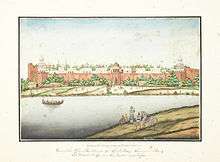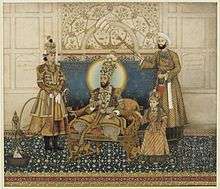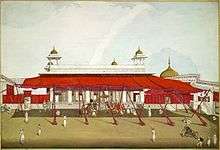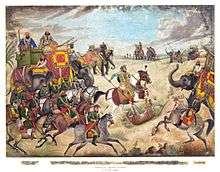Ghulam Ali Khan
Ghulam Ali Khan was a nineteenth century Indian painter in Delhi.[1] He was the last royal Mughal painter, and also painted in the Company style for British patrons.[2]
Ghulam Ali Khan | |
|---|---|
| Born | |
| Died | |
| Known for | Topographical paintings, portraits |
Notable work | |
| Style | Company style |
Career
Ali Khan was the court painter of Mughal emperors Akbar II (reigned 1806–1837) and Bahadur Shah II (reigned 1837–1858) at Delhi. After the completion of his portrait of Akbar II, Ghulam Ali Khan was commissioned to paint the accession portrait of Bahadur Shah II. Versions of the portrait exist in the Smithsonian Museum in Washington DC and the Nasser D. Khalili collection in London.
He created 31 paintings, circa 1852-1854, monuments in and around Delhi, and four portraits of Emperor Bahadur Shah II and his sons. The paintings were in watercolour and gold on paper with black margins; each painting was labelled in English and Persian in nasta'liq script.[3]
He worked for more than ten years at the court of Jhajjar and Alwar court of Raja Baani Singh. He was closely associated with the East India Company, notably William Fraser and James Skinner. These works for William Fraser are included in the Fraser Album.

His Sketches of The Delhee Palace & Delhee from 1854 are a series of 31 paintings, consisting of views of monuments in and around Delhi. Three paintings are dated November 1852. It is possible that the album originally belonged to Sir Thomas Monteath Douglas (1787-1868). The paintings are from the painter's later period. This collection was auctioned in London in 2013.[4]
His work is an important documentation of the Mughal empire towards its end, a companion to Metcalfe's Delhi Book, mostly done by Mazhar Ali Khan.
He was the nephew of noted Mughal painter, Ghulam Murtaza Khan.[5]
Works
 Bahadur Shah II enthroned with Mirza Fakhruddin, 1837–38 (Arthur M. Sackler Gallery, Smithsonian)
Bahadur Shah II enthroned with Mirza Fakhruddin, 1837–38 (Arthur M. Sackler Gallery, Smithsonian) The Diwan-i-Khas with red shamianas, around 1817 (British Library)
The Diwan-i-Khas with red shamianas, around 1817 (British Library) A tiger hunt, 1820 (Victoria & Albert Museum)
A tiger hunt, 1820 (Victoria & Albert Museum) Thakur Dawlat Singh among Courtiers, 1825 (David Collection)
Thakur Dawlat Singh among Courtiers, 1825 (David Collection)
See also
References
- William Dalrymple. "William Dalrymple on The Dehlie Book | Art and design". The Guardian. Retrieved 20 February 2014.
- "Scenes From a Dying Empire". The New York Times. Retrieved 20 February 2014.
- "Bonhams". Bonhams.com. Retrieved 11 January 2014.
- http://www.arcadja.com/auctions/en/ali_khan_ghulam/artist/162437/
- Harshini Vakkalanka (6 February 2013). "Art and an empire". The Hindu. Retrieved 20 February 2014.
Further reading
- Leach, Linda York (1998). Paintings from India. Nour Foundation. p. 1610163. ISBN 978-0-19-727629-7.
- Dalrymple, William (15 July 2013). Princes and Painters: In Mughal Delhi 1707-1857. Penguin Books Limited. pp. 41–51. ISBN 978-93-5118-173-6.
- Losty, Jeremiah P.; Roy, Malini (2012). Mughal India: Art, Culture and Empire : Manuscripts and Paintings in the British Library. British Library. pp. 217–220. ISBN 978-0-7123-5871-2.
External links
![]()